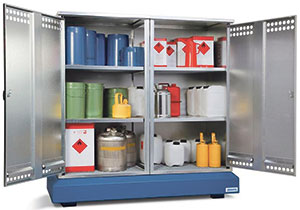When you work with highly flammable or otherwise hazardous materials, you have a duty to ensure that they are stored in safe conditions and in compliance with the law.
 Fire protection refers to the measures put in place to (a) prevent the emergence and spread of a fire (b) to ensure the safety of people and animals and (c) the measures put in place to ensure effective fire extinguishing in the event of a fire. When planning a hazardous goods warehouse, preventive fire protection must be taken into account, in order to minimise possible fire hazards due to the stored substances in advance or to prepare measures for effective firefighting in the event of an emergency. It is divided into structural, technical and organisational measures:
Fire protection refers to the measures put in place to (a) prevent the emergence and spread of a fire (b) to ensure the safety of people and animals and (c) the measures put in place to ensure effective fire extinguishing in the event of a fire. When planning a hazardous goods warehouse, preventive fire protection must be taken into account, in order to minimise possible fire hazards due to the stored substances in advance or to prepare measures for effective firefighting in the event of an emergency. It is divided into structural, technical and organisational measures:
Structural fire protection
Division into fire sections
Requirements for building materials and components
Fire resistance
Safety distances
Technical fire protection
Fire alarm systems
Automatic extinguishing systems
Fire water supply
Smoke and heat exhaust systems
Organisational fire protection
Alarm plans
Fire safety regulations
Escape and rescue plans
Identification
Drills
 DSEAR & the risk assessment
DSEAR & the risk assessment
For all operations in which activities with flammable or oxidising hazardous substances are carried out, The Dangerous Substances and Explosive Atmospheres Regulations (DSEAR) specifies the requirements for a risk assessment, especially with regard to identifying fire hazards and the measures needed to eliminate risks from hazardous materials.
Before work is carried out, employers must assess the fire risks that may be caused by dangerous substances. This should be carried out as part of a risk assessment and by a competent, trained professional. All relevant factors for the rise, spread and impact of a fire must be considered. These include the dangers for employees from smoke, other (toxic) fire products, heat and the failure of components.
Determine protective measures
According to DSEAR employers must put control measures in place to eliminate risks from dangerous substances, or reduce them as far as is reasonably practicable.
The best solution is to eliminate the risk completely by replacing the dangerous substance with another substance, or using a different work process, but in practice this may be difficult to achieve. Where it is not possible to eliminate the risk completely employers must take measures to control risks and reduce the severity of the effects of any harmful event.
Devising emergency plans & procedures
Arrangements must be made to deal with emergencies. These plans and procedures should cover safety drills and suitable communication and warning systems and should be in proportion to the risks. If an emergency occurs, workers tasked with carrying out repairs or other necessary work must be provided with the appropriate equipment to allow them to carry out this work safely.
The information in the emergency plans and procedures must be made available to the emergency services to allow them to develop their own plans if necessary.
European standards and classifications
In the course of the progressive harmonisation of standards in Europe, a largely uniform classification system for fire protection was also introduced and gradually established in the national legislation of some EU states. This is based on the European standards EN 13501-1 and -2. This deals with the classification of the fire behaviour of construction products and the duration of the fire resistance. Essential requirements are the carrying capacity of the construction as well as the spread of fire. These are deemed to be met by the demonstration of the fire resistance of load-bearing and/or space-enclosing components over a certain period of time. This is proved by fire tests. After passing the fire resistance test, the overall system obtains a classification
DENIOS fire protection storage
Anyone who stores hazardous substances has to consider the possible fire hazards and the numerous regulations that surround it. Building regulations must be met and specific requirements for the storage of hazardous materials also play a role. But it is also very important to ensure the safety of people and the environment, and with DENIOS as your partner you are in safe hands.
Our fire proof room systems are designed to hold back fire for up to 120 minutes, giving you time to take any necessary further precautions to ensure the safety of your staff and facilities. We manufacture products specifically tailored to your needs, which are internationally tested and certified as a complete system offering reliable fire protection both inside and out. And because fire protection is a holistic topic, our expert team ensures all-round service in the usual DENIOS quality.
For more information and to speak to one of our hazardous materials storage experts, call us on 01952 700572.
